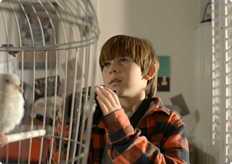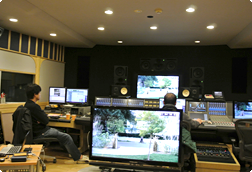
Post-production includes all the processes from the time filming is completed until the movie in its final version is exported to the format for distribution and written onto media. These include management of captured or 'filmed' data, offline editing, online editing, color corrections, image mixing, title and subtitle editing, music and sound effect editing, narration recording and editing. The raw video footage is processed and edited, then mixed with various other data, which often takes as much time as the original filming. These processes take place in editing and sound editing studios, and expert operators handle the sophisticated equipment required.
Preparations for post-production begins the moment filming is completed for each scene. The camera crew, including a Digital Imaging Technician (DIT), stand by at the location to receive the raw data from the shoot (H.264 MOV or uncompressed data), which they back up onto several duplicate hard disks immediately, until all of the day's filming data is preserved. This data is then sent to the editing studio, where it is prepared for offline and subsequent online editing. There are a number of ways to manage the image data, but with the "Through The Lens" data, a substantial amount of filming data, all labeled and categorized according to shooting dates and scene numbers, was imported to Final Cut Pro as uncompressed data and stored by cut, scene, and take.
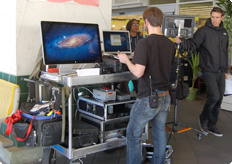
To edit this film, the crew used Final Cut Pro 7 and HD Inferno. Final Cut Pro is the mainstream in Hollywood at the moment because of its ease of use and high-level editing capabilities. Another reason for using it was that data from the D800 can be smoothly transferred to Final Cut Pro, showing that the software is totally compatible with Nikon D-Movie. HD Inferno is a high-end product for editing non-linear HD data and its computing capabilities were utilized to make "Through The Lens" a more artistic and aesthetically interesting movie, with stunning effects and image adjustments. Thus we had two post-production studios; one for editing and one for image adjustments and effects.

First, images are arranged according to the overall flow of the screenplay. The scenes are roughly linked together, but image processing has not yet begun. This process is normally called offline editing or rough editing. This time, with an eye to process efficiency, we used Final Cut Pro to process uncompressed data, and Apple ProRes 422 (HQ) 1,920 x 1,080 to edit the uncompressed HD data, so we were able to apply most of the image modifications and effects at the offline editing stage.
When the flow of the offline editing has been reviewed and approved, it becomes the guide for the online edit. At this stage, colors are corrected as the image white balance, saturation and brightness are adjusted, and image syntheses are added for effects. Finalized titles and subtitles are incorporated, too. The editor, designated and implicitly trusted by the film's director, takes care of this final editing process.
Basically, all the sound used in the movie was recorded by the D800 during the actual shooting. Those recordings were all good enough to use. Only a few sound effects were used to fill in gaps. And "Through The Lens" has no script nor dialogue. Although the film is therefore simple, the role of music in the film becomes much greater. The music used is an arrangement of the well-known opera "Turandot." The director had this music in mind from the beginning. It was played during the shooting and in the studio during editing so the entire crew was able to work with the same image in mind as they did their separate jobs. And during sound editing, a guitarist played while watching the online edit of the film itself. Thus the music perfectly fits the film, scene by scene. Digidesign Pro Tools HD 3 Accel ver. 7.3 (128I/Ox1) software was employed for sound mixing, and digital recording accomplished with a WAV sampling rate 96 kHz 24-bit file.
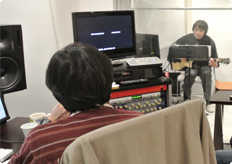
The MA (Multi-audio) process adds sound such as BGM, SE (sound effects), dialogue and narration to an online edit of the film. Various audio elements like the sound recorded in a sound/narration studio or that recorded at shooting locations simultaneously with the movie, as well as SE materials, are mixed to create a full audio package synchronized with the movie file. All of these sounds are integrated to complete "a film with sound". Digidesign Pro Tools HD 3 Accel ver. 7.3 (128I/Ox1) software was also used for the sound mixing of MA, and digital recording accomplished with a WAV sampling rate 96 kHz 24-bit file.
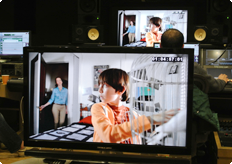
The editing process consists of two data flows: the image data flow, which includes the filming data and the subtitle data, and the sound data flow, which includes narration, dialogue (which this film does not have), sound effects, background music, and other sound data. When these two data flows merge, the film is completed.
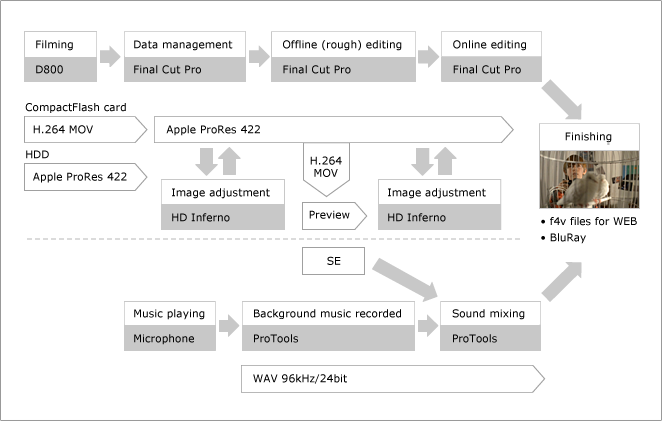
After the online edit and sound editing, the movie is encoded and exported to a distributable medium such as DVD and the entire process — pre-production, production, and post-production — is finished. In all, the crew of "Through The Lens" numbered about 100 people, and the production time, start to finish, took some 90 days. The objective of this project was to produce a feature film that would illustrate full-scale moviemaking. And in the process, we confirmed that the Nikon D800 fits into the Hollywood workflow very well. Some people may think that moviemaking requires a large-scale production process. However, that is definitely not the case. The D800 has the ultra-high definition, the superior AF and AE functions, the high mobility and operability, and an easy-to-use compact body which — combined with a full lineup of NIKKOR lenses and peripherals — empowers you to make the film you envision, even with a very small cast and crew. Yes, it is entirely possible for you to create a work of film art with this camera.
